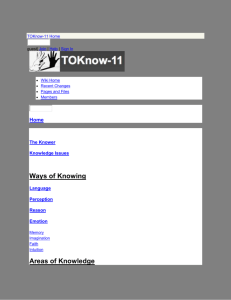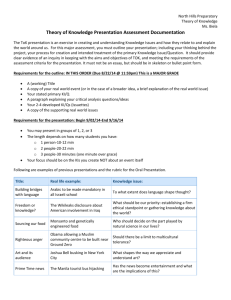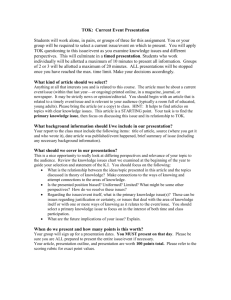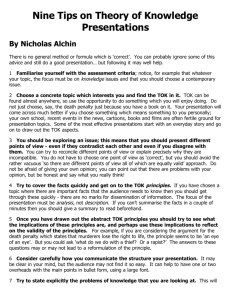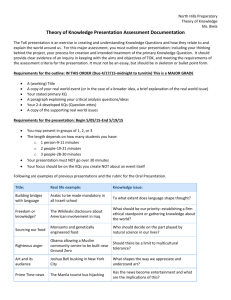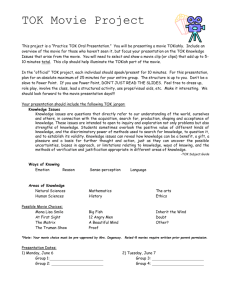TOK presentation
advertisement
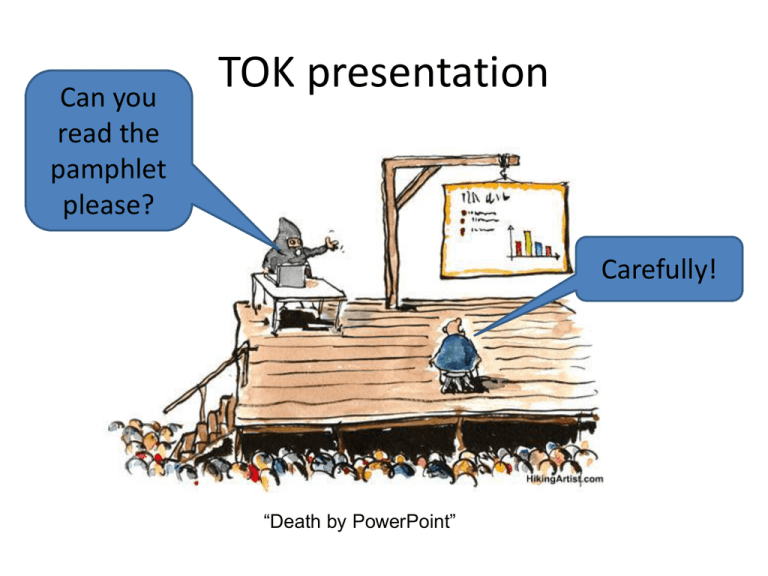
Can you read the pamphlet please? TOK presentation Carefully! “Death by PowerPoint” TOK presentation • The TOK presentation requires students to identify and explore the knowledge issues raised by a substantive real-life situation that is of interest to them. For example Mr Porter would obviously do a Physics related presentation TOK presentation • It is wise to avoid topics so unfamiliar to the class that a great deal of explanation is needed before the underlying knowledge issues can be appreciated and explored. Avoid Quantum Physics TOK presentation • Presentations may take many forms, such as lectures, skits, simulations, games, dramatized readings, interviews or debates. Students may use supporting material such as videos, MS PowerPoint presentations, overhead projections, posters, questionnaires, recordings of songs or interviews, costumes, or props. Under no circumstances, however, should the presentation be simply an essay read aloud to the class. TOK Presentation • Each presentation will have two stages: • an introduction, briefly describing the real-life situation and linking it to one or more relevant knowledge issue • a treatment of the knowledge issue(s) that explores their nature and responses to them, and shows how these relate to the chosen situation. TOK Presentation • A good presentation will demonstrate the presenter’s personal involvement in the topic and show both why the topic is important and how it relates to other areas (see assessment criteria for more details). TOK Presentation • Interaction and audience participation are allowed during the presentation Examples • “Can we be certain that global warming is taking place?” or, “Does language (or the use of statistics, graphs, photographs) affect our view of whether or not the planet is undergoing global warming?” Examples • “How can we know whether intensive farming methods are always harmful?” Examples • “What constitutes responsible journalism? Examples • “What is it that distinguishes an un-made bed from a major work of art that just looks like an un-made bed? Can anything be art—and, if so, what makes it into art?” Examples • Who should decide, and on what grounds, what history should be taught in schools? What part does the notion of historical truth play here? Examples • Are the methods of paleontology more like a science such as physics, or more like history? Examples • What are the similarities between a Physics lesson and a religious service? Marking criteria A; Identification of knowledge issue • Did the presentation identify a relevant knowledge issue involved, implicit or embedded in a real-life situation? • 1–2 - The presentation referred to a knowledge issue but it was irrelevant to the real-life situation under consideration. • 3–4 - The presentation identified a knowledge issue that was in some ways relevant to the real-life situation under consideration. • 5 - The presentation identified a knowledge issue that was clearly relevant to the real-life situation under consideration B; Treatment of knowledge issues • Did the presentation show a good understanding of knowledge issues, in the context of the real-life situation? • 1–2 - The presentation showed some understanding of knowledge issues. • 3–4 - The presentation showed an adequate understanding of knowledge issues. • 5 - The presentation showed a good understanding of knowledge issues. C; Knower's perspective • Did the presentation, particularly in the use of arguments and examples, show an individual approach and demonstrate the significance of the topic? • 1–2 - The presentation, in its use of arguments and examples or otherwise, showed limited personal involvement and did not demonstrate the significance of the topic. • 3–4 - The presentation, in its use of arguments and examples or otherwise, showed some personal involvement and adequately demonstrated the significance of the topic. • 5 - The presentation, in its distinctively personal use of arguments and examples or otherwise, showed clear personal involvement and fully demonstrated the significance of the topic. D; Connections • Did the presentation give a balanced account of how the topic could be approached from different perspectives? • Did the presentation show how the positions taken on the knowledge issues would have implications in related areas? • 1–2 - The presentation explored at least two different perspectives to some extent. • 3–4 - The presentation gave a satisfactory account of how the question could be approached from different perspectives, and began to explore their similarities and differences. • 5 - The presentation gave a clear account of how the question could be approached from different perspectives and considered their implications in related areas. TOK Presentation • Before the presentation, the individual or group must give the teacher a copy of the presentation planning document (see below). The document is not to be handed out to the audience. Presentation planning document When is it due?!
